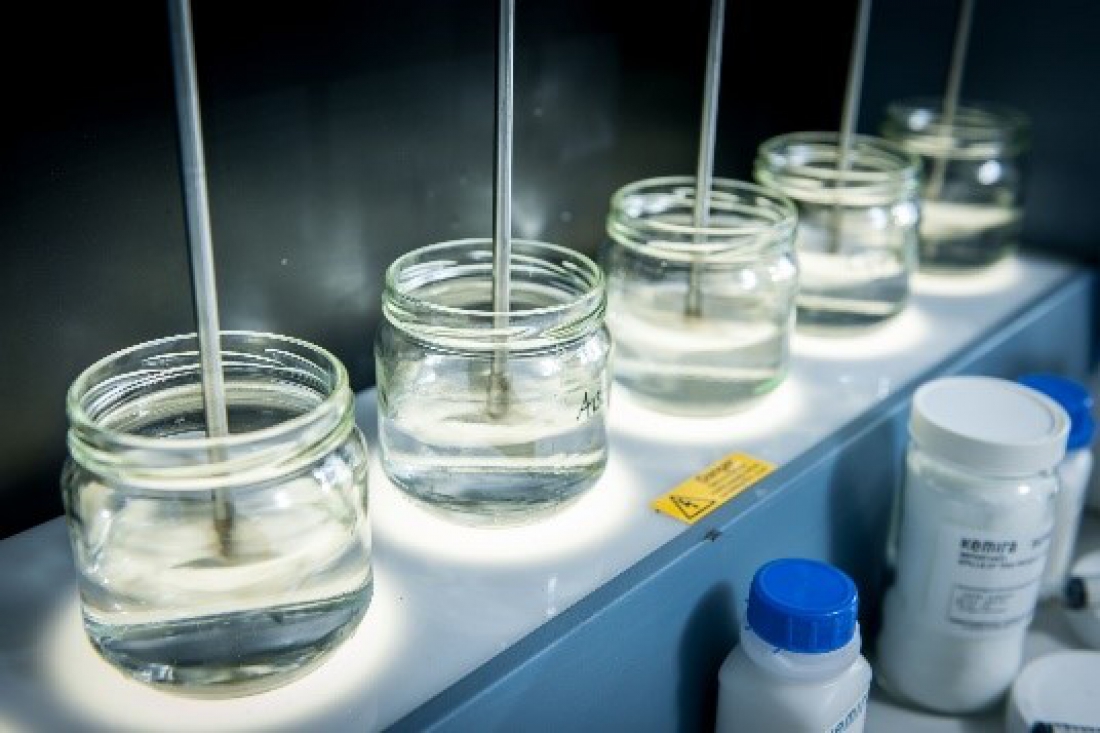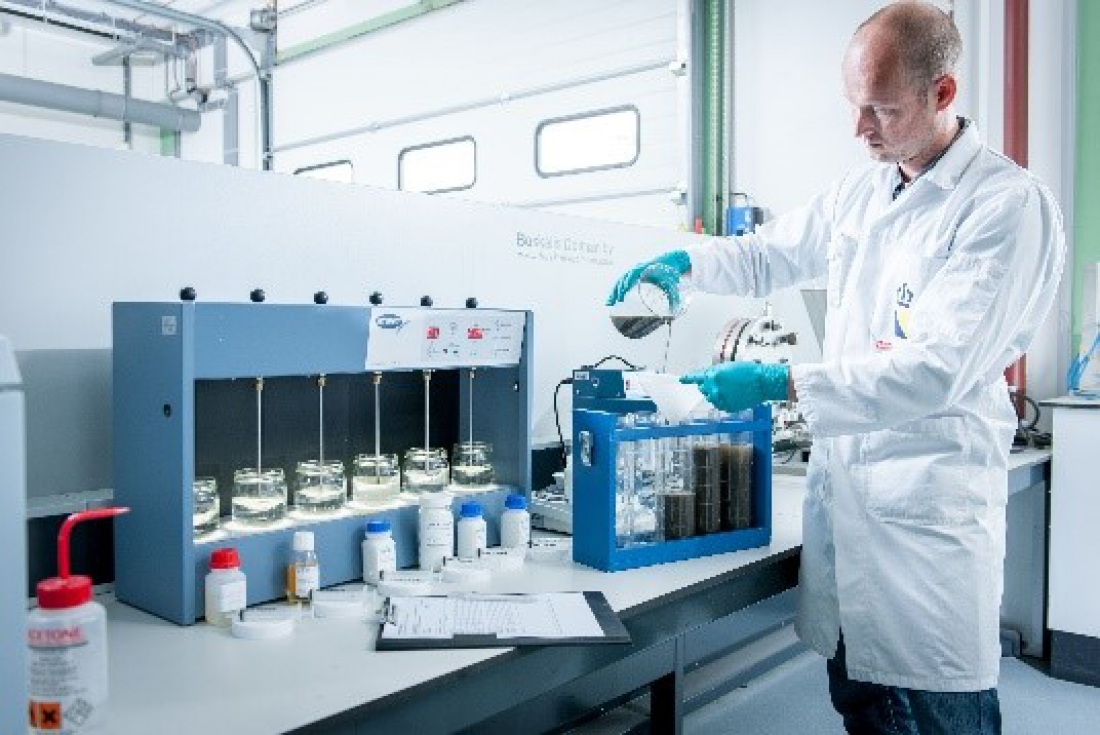Feasibility study soil washing PFAS contaminated soil
The project
Boskalis Environmental has its own laboratory facility. In this facility PCTS members can execute various geophysical tests. At the facility feasibility tests for soil washing of contaminated soil and other minerals streams can be performed. The lab is also equipped to test dewatering properties of the separated sludge fraction. Since 2018 the laboratory also provides feasibility tests soil washing for PFAS impacted soil.
The first feasibility tests were performed prior to the regulatory approval by the Dutch government of (temporary) reuse criteria for PFAS impacted soils. PFAS was found to be a frequently encountered component for which (at that time) no regulatory framework for reuse existed. Those first feasibility tests showed that it PFAS could be removed from the soil with an average efficiency of 95%. It also became clear that the PFAS accumulated for the most part in the fines fraction (silt and organic/humic fraction).
Since that time numerous feasibility tests soil washing have been executed that underline the potential of soil washing of PFAS contaminated soils. Tests have been performed on several soil types, varying in PFAS content.
Boskalis Environmental can perform these tests upon your request. Two test procedures have been developed: a simple and extensive test procedure and a more thorough test procedure. The data of the latter procedure are a clear indication of what efficiency can be obtained under full-scale conditions.
Treatment of the water phase has also been tested by mean of granular activated carbon (GAC) or more innovative types of adsorbents.
Project data
Location project: Laboratory facility of Boskalis Environmental, Papendrecht, The Netherlands
Executed by: Boskalis Environmental
Contact person: Joop Jansen (joop.jansen@boskalis.com)
Feasibility study soil washing PFAS contaminated soil
The project
Boskalis Environmental has its own laboratory facility. In this facility PCTS members can execute various geophysical tests. At the facility feasibility tests for soil washing of contaminated soil and other minerals streams can be performed. The lab is also equipped to test dewatering properties of the separated sludge fraction. Since 2018 the laboratory also provides feasibility tests soil washing for PFAS impacted soil.
The first feasibility tests were performed prior to the regulatory approval by the Dutch government of (temporary) reuse criteria for PFAS impacted soils. PFAS was found to be a frequently encountered component for which (at that time) no regulatory framework for reuse existed. Those first feasibility tests showed that it PFAS could be removed from the soil with an average efficiency of 95%. It also became clear that the PFAS accumulated for the most part in the fines fraction (silt and organic/humic fraction).
Since that time numerous feasibility tests soil washing have been executed that underline the potential of soil washing of PFAS contaminated soils. Tests have been performed on several soil types, varying in PFAS content.
Boskalis Environmental can perform these tests upon your request. Two test procedures have been developed: a simple and extensive test procedure and a more thorough test procedure. The data of the latter procedure are a clear indication of what efficiency can be obtained under full-scale conditions.
Treatment of the water phase has also been tested by mean of granular activated carbon (GAC) or more innovative types of adsorbents.
Project data
Location project: Laboratory facility of Boskalis Environmental, Papendrecht, The Netherlands
Executed by: Boskalis Environmental
Contact person: Joop Jansen (joop.jansen@boskalis.com)
Feasibility study soil washing PFAS contaminated soil
The project
Boskalis Environmental has its own laboratory facility. In this facility PCTS members can execute various geophysical tests. At the facility feasibility tests for soil washing of contaminated soil and other minerals streams can be performed. The lab is also equipped to test dewatering properties of the separated sludge fraction. Since 2018 the laboratory also provides feasibility tests soil washing for PFAS impacted soil.
The first feasibility tests were performed prior to the regulatory approval by the Dutch government of (temporary) reuse criteria for PFAS impacted soils. PFAS was found to be a frequently encountered component for which (at that time) no regulatory framework for reuse existed. Those first feasibility tests showed that it PFAS could be removed from the soil with an average efficiency of 95%. It also became clear that the PFAS accumulated for the most part in the fines fraction (silt and organic/humic fraction).
Since that time numerous feasibility tests soil washing have been executed that underline the potential of soil washing of PFAS contaminated soils. Tests have been performed on several soil types, varying in PFAS content.
Boskalis Environmental can perform these tests upon your request. Two test procedures have been developed: a simple and extensive test procedure and a more thorough test procedure. The data of the latter procedure are a clear indication of what efficiency can be obtained under full-scale conditions.
Treatment of the water phase has also been tested by mean of granular activated carbon (GAC) or more innovative types of adsorbents.
Project data
Location project: Laboratory facility of Boskalis Environmental, Papendrecht, The Netherlands
Executed by: Boskalis Environmental
Contact person: Joop Jansen (joop.jansen@boskalis.com)
Feasibility study soil washing PFAS contaminated soil
The project
Boskalis Environmental has its own laboratory facility. In this facility PCTS members can execute various geophysical tests. At the facility feasibility tests for soil washing of contaminated soil and other minerals streams can be performed. The lab is also equipped to test dewatering properties of the separated sludge fraction. Since 2018 the laboratory also provides feasibility tests soil washing for PFAS impacted soil.
The first feasibility tests were performed prior to the regulatory approval by the Dutch government of (temporary) reuse criteria for PFAS impacted soils. PFAS was found to be a frequently encountered component for which (at that time) no regulatory framework for reuse existed. Those first feasibility tests showed that it PFAS could be removed from the soil with an average efficiency of 95%. It also became clear that the PFAS accumulated for the most part in the fines fraction (silt and organic/humic fraction).
Since that time numerous feasibility tests soil washing have been executed that underline the potential of soil washing of PFAS contaminated soils. Tests have been performed on several soil types, varying in PFAS content.
Boskalis Environmental can perform these tests upon your request. Two test procedures have been developed: a simple and extensive test procedure and a more thorough test procedure. The data of the latter procedure are a clear indication of what efficiency can be obtained under full-scale conditions.
Treatment of the water phase has also been tested by mean of granular activated carbon (GAC) or more innovative types of adsorbents.
Project data
Location project: Laboratory facility of Boskalis Environmental, Papendrecht, The Netherlands
Executed by: Boskalis Environmental
Contact person: Joop Jansen (joop.jansen@boskalis.com)
Feasibility study soil washing PFAS contaminated soil
The project
Boskalis Environmental has its own laboratory facility. In this facility PCTS members can execute various geophysical tests. At the facility feasibility tests for soil washing of contaminated soil and other minerals streams can be performed. The lab is also equipped to test dewatering properties of the separated sludge fraction. Since 2018 the laboratory also provides feasibility tests soil washing for PFAS impacted soil.
The first feasibility tests were performed prior to the regulatory approval by the Dutch government of (temporary) reuse criteria for PFAS impacted soils. PFAS was found to be a frequently encountered component for which (at that time) no regulatory framework for reuse existed. Those first feasibility tests showed that it PFAS could be removed from the soil with an average efficiency of 95%. It also became clear that the PFAS accumulated for the most part in the fines fraction (silt and organic/humic fraction).
Since that time numerous feasibility tests soil washing have been executed that underline the potential of soil washing of PFAS contaminated soils. Tests have been performed on several soil types, varying in PFAS content.
Boskalis Environmental can perform these tests upon your request. Two test procedures have been developed: a simple and extensive test procedure and a more thorough test procedure. The data of the latter procedure are a clear indication of what efficiency can be obtained under full-scale conditions.
Treatment of the water phase has also been tested by mean of granular activated carbon (GAC) or more innovative types of adsorbents.
Project data
Location project: Laboratory facility of Boskalis Environmental, Papendrecht, The Netherlands
Executed by: Boskalis Environmental
Contact person: Joop Jansen (joop.jansen@boskalis.com)
Feasibility study soil washing PFAS contaminated soil
The project
Boskalis Environmental has its own laboratory facility. In this facility PCTS members can execute various geophysical tests. At the facility feasibility tests for soil washing of contaminated soil and other minerals streams can be performed. The lab is also equipped to test dewatering properties of the separated sludge fraction. Since 2018 the laboratory also provides feasibility tests soil washing for PFAS impacted soil.
The first feasibility tests were performed prior to the regulatory approval by the Dutch government of (temporary) reuse criteria for PFAS impacted soils. PFAS was found to be a frequently encountered component for which (at that time) no regulatory framework for reuse existed. Those first feasibility tests showed that it PFAS could be removed from the soil with an average efficiency of 95%. It also became clear that the PFAS accumulated for the most part in the fines fraction (silt and organic/humic fraction).
Since that time numerous feasibility tests soil washing have been executed that underline the potential of soil washing of PFAS contaminated soils. Tests have been performed on several soil types, varying in PFAS content.
Boskalis Environmental can perform these tests upon your request. Two test procedures have been developed: a simple and extensive test procedure and a more thorough test procedure. The data of the latter procedure are a clear indication of what efficiency can be obtained under full-scale conditions.
Treatment of the water phase has also been tested by mean of granular activated carbon (GAC) or more innovative types of adsorbents.
Project data
Location project: Laboratory facility of Boskalis Environmental, Papendrecht, The Netherlands
Executed by: Boskalis Environmental
Contact person: Joop Jansen (joop.jansen@boskalis.com)
Feasibility study soil washing PFAS contaminated soil
The project
Boskalis Environmental has its own laboratory facility. In this facility PCTS members can execute various geophysical tests. At the facility feasibility tests for soil washing of contaminated soil and other minerals streams can be performed. The lab is also equipped to test dewatering properties of the separated sludge fraction. Since 2018 the laboratory also provides feasibility tests soil washing for PFAS impacted soil.
The first feasibility tests were performed prior to the regulatory approval by the Dutch government of (temporary) reuse criteria for PFAS impacted soils. PFAS was found to be a frequently encountered component for which (at that time) no regulatory framework for reuse existed. Those first feasibility tests showed that it PFAS could be removed from the soil with an average efficiency of 95%. It also became clear that the PFAS accumulated for the most part in the fines fraction (silt and organic/humic fraction).
Since that time numerous feasibility tests soil washing have been executed that underline the potential of soil washing of PFAS contaminated soils. Tests have been performed on several soil types, varying in PFAS content.
Boskalis Environmental can perform these tests upon your request. Two test procedures have been developed: a simple and extensive test procedure and a more thorough test procedure. The data of the latter procedure are a clear indication of what efficiency can be obtained under full-scale conditions.
Treatment of the water phase has also been tested by mean of granular activated carbon (GAC) or more innovative types of adsorbents.
Project data
Location project: Laboratory facility of Boskalis Environmental, Papendrecht, The Netherlands
Executed by: Boskalis Environmental
Contact person: Joop Jansen (joop.jansen@boskalis.com)




-
- PFAS Cleaning Treatment Solutions
- PFAS Cleaning Treatment Solutions
-
- info@pfasoplossingen.nl
-
- Phone number
- +31(0)646647255




